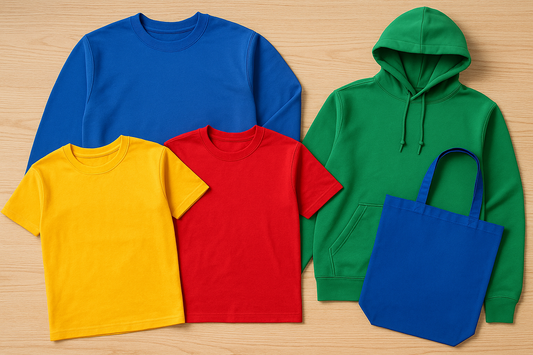Excellent print made t-shirts for some teachers.

What are the Best Practices for DTF Transfer Application
DTF transfers are revolutionizing custom apparel printing. They offer vibrant colors and intricate designs. This guide will help you master DTF transfer application. You'll learn best practices for achieving high-quality results. Whether you're a small business owner or a DIY enthusiast, this guide is for you. We'll cover everything from preparation to post-pressing care.
Get ready to enhance your custom apparel with DTF transfers.
What Are DTF Transfers? An Overview
DTF stands for Direct to Film. It's a printing process that transfers designs to various fabrics. This method offers durability and flexibility unmatched by other techniques. For a deeper dive into the broader digital textile printing landscape, resources from organizations like PRINTING United Alliance provide extensive information.
DTF transfers involve printing your design on a special film. After printing, you use heat to transfer the design onto the garment. This process allows for vibrant and intricate images.
Key benefits of DTF transfers include:
- Versatile application on different fabrics.
- Bright colors and detailed designs.
- Long-lasting prints resistant to cracking.
DTF transfers are perfect for custom t-shirts, hoodies, and more. They are a good option for small projects. These projects require individual DTF transfers by size. They are also suitable for large production runs. These runs can use custom DTF gang sheets.
For a full breakdown of the advantages for your business, explore the 5 Benefits of DTF Transfers for T-Shirt Businesses.
Essential Tools and Materials for DTF Transfer Application
Getting started with DTF transfers requires specific tools and materials. Gathering these essentials beforehand ensures a smooth workflow. The right setup is crucial for high-quality results.
Here's what you'll need:
- DTF Transfer Sheets: Choose high-quality sheets for the best results. You can find premium DTF Transfer Sheets available in various sizes on our site.
- Heat Press Machine: Essential for applying the right pressure and heat. (For general information on operating and maintaining heat transfer equipment safely, consult guides from organizations focused on workplace safety standards.)
- Teflon Sheet or Parchment Paper: To protect your design during pressing.
- Garment: Ensure it's suitable for DTF transfer.
- Lint Roller: To clean the garment surface before application.

Having these tools at hand prepares you well for the transfer process, resulting in vibrant, durable designs.
Preparing Your Workspace and Garments
A well-organized workspace can significantly impact your DTF transfer results. Begin by ensuring the area is clean and free from clutter. This prevents any dust or debris from interfering with your transfer.
Next, focus on your garments. It's crucial to prepare them before application. Ensure that the garment is clean and free of residues that could affect adhesion. Use a lint roller to remove any fibers or dust.
Additionally, preheat your garment using the heat press to eliminate moisture and wrinkles. This step helps the transfer adhere more effectively. Creating a conducive environment also minimizes errors and maximizes the life of your designs.
Key preparation steps include:
- Clean workspace
- Remove dust with a lint roller
- Preheat garments to remove moisture
- Ensure garments are wrinkle-free
These preparations ensure a high-quality transfer, setting the foundation for professional-looking results.
Step-by-Step Guide: Applying DTF Transfers
Applying DTF transfers might seem daunting, but with the right steps, it becomes straightforward. Begin by gathering all necessary materials and tools. This includes your custom DTF prints, a heat press, Teflon sheet, and lint roller.
First, ensure your garment is ready. Cleanliness is key, so check your workspace and garment before you start.
Next, move to the positioning phase. Align the DTF transfer sheet carefully on the garment. Ensure the design is where you want it.
Setting the heat press correctly is crucial. Adjust the temperature, pressure, and time according to the transfer sheet instructions. These settings can vary depending on fabric and transfer sheet type. For a detailed guide on common heat press settings, refer to our How to Use a Heat Press for DTF Transfer guide.
Press with consistency for the perfect transfer. Ensure an even application of pressure.
After pressing, allow the transfer to cool slightly. Peel back the film carefully once cooled.
Perform quality checks after peeling. Ensure the design is fully adhered and looks as expected.
List of steps for applying DTF Transfers:
- Gather tools and materials.
- Clean and prepare garment and workspace.
- Position transfer sheet accurately.
- Adjust heat press settings.
- Press evenly.
- Allow cooling before peeling.
- Conduct a quality check.
By following these steps, you can achieve impressive results with DTF transfers. Practice and attention to detail will hone your skills.
1. Prepping the Garment
Preparation is vital for great DTF transfer results. Start by using a lint roller on the garment. This removes dust that could impact adhesion.
Preheating is also important. Use the heat press to warm the garment slightly. This removes any moisture, ensuring a smooth base for the transfer.

Key garment prep steps include:
- Use a lint roller
- Preheat to remove moisture
- Ensure the garment is flat
2. Positioning the DTF Transfer Sheet
Proper alignment prevents mishaps. Begin by laying the garment on a flat surface. Place the DTF transfer sheet carefully on the garment, ensuring proper alignment.
Double-check the positioning. Misaligned designs can ruin the final look. Adjust until you are satisfied with the placement.
Steps for positioning:
- Lay garment flat
- Place transfer sheet correctly
- Check and adjust alignment
3. Heat Press Settings: Temperature, Pressure, and Time
Each transfer requires precise settings. Check the instructions for the specific DTF transfer sheets you’re using. Adjust the heat press to the recommended temperature.
Pressure is crucial for adhesion. Ensure it’s set correctly to avoid damage or weak bonds. Finally, set the timer according to guidelines, ensuring it matches the transfer sheet requirements.
Heat press settings checklist:
- Set recommended temperature
- Adjust pressure accordingly
- Set timer to specified duration
4. Pressing and Peeling Techniques
Pressing is where the magic happens. Lower the heat press and apply even pressure for the designated time. Use a Teflon sheet on top for protection.
After pressing, let it cool slightly for easier peeling. Gently peel back the film, ensuring the design adheres properly. Check for any areas needing re-pressing.
Pressing and peeling steps include:
- Apply even pressure
- Let cool slightly
- Peel gently and check results
Post-Pressing: Curing, Cooling, and Quality Checks
Curing is essential to ensure the durability of DTF transfers. After pressing, allow the garment to sit undisturbed. This period helps solidify the adhesion of the transfer to the fabric.
Cooling down properly is just as crucial. It ensures that the transfer cures as intended without disturbance. Make sure the garment is completely cooled before handling it.
Perform thorough quality checks once the cooling process is complete. Inspect for any lifting edges or uneven areas. If needed, re-press any sections that appear problematic to secure the best outcome.
Checklist for post-pressing:
- Allow to sit undisturbed
- Ensure complete cooling
- Inspect for quality and re-press if necessary
Washing and Care Instructions for DTF Prints
Proper care extends the life of DTF prints. Follow washing guidelines meticulously to maintain vibrancy. Avoid harsh washing conditions. For general guidance on garment care and textile standards, the American Association of Textile Chemists and Colorists (AATCC) offers valuable insights
Turn garments inside out before washing. This reduces abrasion on the design. Use cold water and gentle cycles to prevent damage.
Air-drying is preferable as it helps retain the integrity of the transfer. Avoid direct ironing on the print. If needed, place a cloth over the design before ironing.
Washing Tips for DTF Prints:
- Use cold water
- Turn garments inside out
- Air-dry, avoid heat settings
- Place cloth before ironing
Troubleshooting Common DTF Transfer Issues
Encountering issues with DTF transfers can be frustrating. However, most problems have simple solutions. For more detailed solutions to common problems, visit our DTF Troubleshooting FAQ page.
If transfers are not adhering properly, check heat settings. Ensure the press has consistent, even pressure. Incorrect temperatures might also compromise adhesion.
Fading colors can signal over-washing or incorrect wash settings. Always follow recommended care instructions to prevent color loss. Consider using detergents safe for colored fabrics.
Common DTF Transfer Issues:
- Poor adhesion
- Fading colors
- Peeling edges
Peeling edges often indicate improper pressure or incorrect film positioning. Recheck your heat press calibration and alignment. Ensure your fabric is free of contaminants.
Quick Troubleshooting Tips:
- Adjust heat press settings
- Verify pressure consistency
- Clean fabric surface before application
Familiarize yourself with common challenges. Practice regularly to develop your troubleshooting skills. Being proactive prevents future transfer problems.
Tips for Achieving the Best Results with DTF Transfers
Enhancing your DTF transfer results involves practice and precision. Pay attention to each step in the process and make small adjustments where necessary. A few targeted strategies can make a noticeable difference.
Focus on refining your technique to avoid common pitfalls. Small changes can lead to major improvements in the final product.
Key Tips for DTF Success:
- Follow precise heat and pressure settings
- Use high-quality transfer sheets
- Clean and prep garments thoroughly before pressing
Incorporate these practices to enhance both quality and durability. By committing to continual improvement, you’ll achieve vibrant and long-lasting DTF transfers that satisfy both personal and customer expectations.
Where to Buy DTF Transfers and Custom DTF Prints
Finding reliable suppliers for DTF transfers is crucial. Many online retailers specialize in custom DTF prints and transfer sheets. Researching these sources ensures you get high-quality materials that meet your needs. While online marketplaces can offer options, for consistent quality, reliability, and dedicated support, we recommend choosing specialized printing suppliers. At Sam's DTF Transfers, we pride ourselves on providing high-quality custom DTF prints and transfer sheets
Consider vendors who offer a variety of products and sizes. This flexibility allows customization for any project.
Places to buy DTF transfers:
- Online marketplaces like Amazon and Etsy
- Specialized printing suppliers
- Wholesale websites for bulk orders
Choosing the right supplier enhances your project’s success. Quality transfers lead to vibrant and durable designs. See what our customers are saying in our Customer Reviews.
Frequently Asked Questions About DTF Transfer Application
What is a DTF transfer?
A DTF transfer is a custom print process. It involves printing a design on a film and then transferring it to fabric.
Can DTF transfers be used on any fabric?
Yes, they are versatile. Suitable fabrics include cotton, polyester, and blends.
What should I do if the design peels off?
Check your heat press settings. Ensure proper pressure and temperature for best adhesion.
Are DTF transfers durable?
When applied correctly, they withstand multiple washes. Proper care ensures long-lasting designs.
How do I store DTF transfer sheets?
Store them flat in a cool, dry area. Avoid direct sunlight to maintain their quality.
Can DTF transfers be layered for more colors?
Yes, layering is possible. This allows for intricate and vibrant multi-color designs.
Conclusion: Mastering DTF Transfer Application for Lasting Results
Achieving perfection with DTF transfers is within reach with practice and patience. By mastering the preparation and application processes, you can consistently produce top-quality custom apparel. Each step, from choosing the right materials to setting precise heat press conditions, significantly impacts the final result.
Always follow manufacturer instructions and test your settings. This prevents costly errors and ensures vibrant, durable prints. Remember, minor adjustments can make a significant difference in quality.
Stay informed about new techniques and products. As the DTF transfer industry evolves, adapting your skills ensures you remain competitive. Craft unique, long-lasting designs that exceed expectations with these best practices.
Ready to start creating your own professional custom apparel? Explore our selection of high-quality DTF Transfers and transform your designs into lasting garments today!
No comments











0 comments